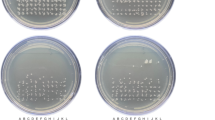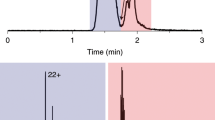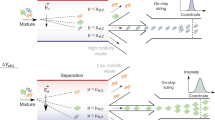Abstract
The growth of industrial biotechnology has had a major impact on the research and development of both analytical and preparative focusing techniques. Pioneering methods such as isoelectric focusing are being modified to overcome the limitations of batch mode Operation, scale up difficulties, high power requirement, and excessive heat generation. Present advances in focusing techniques have been made by either overcoming the limitations of standard techniques or by investigating new focusing systems. Here we review the background and history of isoelectric focusing and discuss several new focusing techniques including recycle isoelectric focusing (RIEF), counteracting chromatographic electrophoresis (CACE), and countercurrent gradient chromatography (CGC).
This is a preview of subscription content, access via your institution
Access options
Subscribe to this journal
Receive 12 print issues and online access
$209.00 per year
only $17.42 per issue
Buy this article
- Purchase on Springer Link
- Instant access to full article PDF
Prices may be subject to local taxes which are calculated during checkout
Similar content being viewed by others
References
Dechow, F.J. 1989. Separation and Purification Technology in Biotechnology. Noyes Publications, Park Ridge, New Jersey.
Lightfoot, E.N. and Cockrem, M.C.M. 1987. What are dilute solutions. Separation Science and Technology 22: 165–189.
Heftman, E. 1975. Chromatography, a Laboratory of Chromatographic and Electrophoretic Methods. Van Nostrand Reinhold Co., New York.
Righetti, P.G. 1983. Isoelectric Focusing: Theory, Methodology, and Applications. Elsevier Biomedical Press, Amsterdam.
Schumacher, E. 1957. Uber Fokussierenden lonenaustausch IV. Zur Theorie des Fokussierungseffektes. Helvetica Chimica Ada, No. 240: 2322–2340.
Kauman, W.G. 1957. Classe des Sciences de L'Academie Royale de Belgique 43: 854–868.
Svensson, H. 1961. Isoelectric fractionation, analysis, and characterization of ampholytes in natural pH gradients. I. The differential equation of solute concentration at steady state and its solution for simple cases. Acta Chemica Scandinavica 15: 325–341.
Vesterburg, O. and Svensson, H. 1996. Isoelectric fractionation, analysis, and characterization of ampholytes in natural pH gradients IV. Further studies on the resolving power in connection with separation of myoglobins. Acta Chemica Scandinavica 20: 820–834.
Caspers, M.L. and Chrambach, A. 1977. Natural pH gradients formed by amino acids: Ampholyte distribution, time course, use in electrofocusing of protein, relation to pH gradients in isotachophoresis, and separator effects. Anal. Biochem. 81: 28–39.
Vesterburg, O. 1969 Synthesis and isoelectric fractionation of carrier ampholytes. Acta Chemica Scandinavica. 23: 2653–2666.
Bier, M., Ostream, J. and Marquez, R.B. 1933 A new buffering system and its use in electrophoresis and isoelectric focusing. Electrophoresis 14(10): 1011–1018.
Hausfeld, A.D. 1993. Isoelectric focusing: pH gradients established with simple buffers and a cation-selective membrane. Analytical Biochemistry 212: 237–246.
Carrier ampholytes are available from a number of suppliers including BIO-RAD Laboratories (Richmond, CA) and Pharmacia Biotech Inc. (Piscataway, NI).
Isoelectric focusing units are available from a number of suppliers including BIO-RAD Laboratories (Richmond, CA) and RAININ (Woburn, MA).
Bjellqvist B., Ek K. Righetti, P.G., Gianazza E. Gorg A., Westermeir, R. and Postel, W.J. 1982. Biophy. Methods. Isoelectric focusing in immobilized pH gradients: Principle, methodology, and some appilications. J. Biochem. 6: 317–339.
Righetti, P.G., Barzachi, B., Luzanna, M., Manfredi, G. and Faupel, M. 1987. A horizontal apparatus for isoelectric protein purification in a segmented immobilized pH gradient. Biochemical and Biophysical Methods 15: 189–198.
Altland, K. and Altland, A. 1990. Pouring wide renge immobilized pH gradients with a window of extremely flattened slope. Electrophoresis 11: 337–342.
Mosher, R.A., Thormann, W. and Bier, M. 1988. Experimental and theoretical dynamics of isoelectric focusing, II. Elucidation of the impact of the electrode assembly. J. of Chromatogr. 436: 191–204.
Coronel, E.C., Little, B.W. and Alhadeff, J. A. 1993. Immobilized pH gradient focusing of alkaline proteins: Analysis of the isoform composition of purified human non-secretory ribonucleases from kidney, liver and spleen. Biochemical Journal 296: 553–556.
Righetti, P.G. and Chiari, M. 1993. Conventional isoelectric focusing and immobilized pH gradients: An overview. Chromatogr. Science Series (Capillary Electrophoresis Technology) 64: 89–116.
Sinha, P., Galacteros, F., Righetti, P.G., Kohlmeier, M. and Koettgen, E. 1993. Analysis of hemoglobin variants using immobilized pH gradients. Eur. J. Clin. Chem. Clin. Biochem. 31: 91–96.
Altland, K. 1990. IPGMAKER: A program for IBM-compatible personal computers to create and test recipes for immobilized pH gradients. Electrophoresis 11: 140–147.
Tonani, C. and Righetti, P.G. G 1991. Immobilized pH gradients (IPG) simulator—an additional step in pH gradient engineering: I. Linear pH gradients. Electrophoresis 12: 1011–1021.
Celentano F.C., Gianazza, E. and Righetti, P.G. 1991. On the computational approach to immobilized pH gradients. Electrophoresis 12: 693–703.
Giaffreda, E., Tonani, C. and Righetti, P.G. 1992. pH Gradient simulator for electrophoretic techniques in a Windows environment. J. of Chromatography 630: 313–327.
Bjellqvist, B., Hughes, G.J., Pasquali, C., Paquet, N., Ravier, F., Sanchez, J.C., Frutiger, S. and Hochstrasser, D. 1993. The focusing positions of polypeptides in immobilized pH gradients can be predicted from their amino acid sequences. Electrophoresis 14: 1023–1031.
Righetti, P.G., Gianazza, E., Bianchi-Bosisio, A., Wajeman, H. and Cossu, G. 1989. ElectrophoreticaUy silent hemoglobin mutants as revealed by isoelectric focusing in immobilized pH gradients. Electrophoresis 10: 595–599.
The automatic Phast Gel System is available from Pharmacia Biotech Inc (Piscataway, NJ).
Fawcett, J.S. and Chrambach, A. 1986. The voltage across wide pH range immobilized pH gradient gels and its modulation through the addition of carrier ampholytes. Electrophoresis 7: 266–272.
Altland, K., Hackler, R. and Rossman, U. 1986. Avoiding liquid exudation on the surface of rehydrated gels for hybrid isoelectric focusing in carrier ampholyte supplemented immobilized pH gradients. Electrophoresis 7: 251–259.
Astrua-Testori, S. and Righetti, P.G. 1987. Mechanism of water exudation from mixed-bed ampholine-immobiline gels for isoelectric focusing. J. of Chromatogr. 387: 121–126.
Altland, K., Becher, P. and Banzhoff A., 1987. Paraffin oil protected high resolution hybrid isoelectric focusing for the demonstration of substitutions of neutral amino acids in denatured proteins: The case of four human transthyretin (prealbumin) variants associated with famillial amyloidotic polyneuropathy. Electrophoresis 8: 293–297.
Altland, K., Becher, P., Rossmann, U. and Bjellqvist, B. 1988. Isoelectric focusing of basic proteins: The problem of oxidation of cysteins. Electrophoresis 9: 474–485.
Chrambach, A. 1985. The Practice of Quantitative Gel Electrophoresis, VCH Publishers, Weinheim, Germany.
Hanash, S.M., Strahler, J.R., Somerlot, L., Postel, W. and Gorg, A. 1987. Two-dimensional electrophoresis with immobilized pH gradients in the first dimension: Protein focusing as a function of time. Electrophoresis 8: 229–234.
Vocanson, C., Honnorat,J. Aguera,M. Antoinne,J.C. and Caudie,C. 1994. High resolution two dimensional polyacrylamide gel electrophoresis using immobilines. Application to the study of brain proteins. Cell. Mol. Biol. 40 9–16.
Tissot, J.D., Hohfeld, P., Forestier, F., Tolsa, J.F., Hochstrasser, D.F., Calame, A., Plouvier, E., Bossart, H. and Schneider, P. 1993. Plasma/serum protein patterns in human fetuses and infants: A study by high resolution two dimensional polyacrylamide gel electrophoresis. Applied Theoretical Electrophoresis 3: 183–190.
Fenton, B. 1993. Two-dimensional polyacrylamide gel electrophoresis. Methods Mol. Biol 21: 349–59.
Gorg, A. 1993. Two-dimensional electrophoresis with immobilized pH gradients: Current state. Biochem. Soc. Trans. 21: 130–2.
Gianazza, E., Caccia, P., Quaglia, L. and Righetti, P.G. 1986. Two-dimensional analysis of membrane proteins with isoelectric focusing in immobilized pH gradients in the first dimension. Electrophoresis 7: 537–543.
Vesterburg, O. 1993. A short history of electrophoretic methods. Electrophoresis 14: 1243–1249.
Hannig, K. 1961. Die Tragerfrie Kontinuierliche Elektrophorese Und Due Anwendung. Z. Anal. Chem. 181: 244–254.
Bier, M. and Egen, N.B. 1979. In: Developments in Biochemistry. Hagland, H., Westerfield, D. G. and Ball, J. T., (Eds. ). Vol. 7, Elsevier-North Holland, Amsterdam.
Egen, N.B., Twitty, O.E. and Bier, M. 1979. 17th Aerospace Sciences Meeting, New Orleans, LA, Jan. 15–17, document 79-0405.
Hannig, K. and Heidrich, H.G. 1974. The use of continuous preparative freeflow electrophoresis for dissociating cell fractions and isolation of membranous components. Methods in Enzymology 31: 746–761.
Mattock, P. 1980 Velocity gradient stabilized continuous, free flow electrophoresis. A review. Separation and Purification Methods 9: 1–68.
Naumann, R.J. and Rhodes, P.H. 1984. Thermal considerations in continuous flow electrophoresis. Separation Science and Technology 19: 51–75.
Bier, M., Egen, N.B., Allgyer, T.T., Twitty, G.E. and Mosher, R. A. 1979 p. 79–89. In: Peptides: Structure and Biological Function, Gross, E. and Meienhofer, J. (Eds. ), Pierce, Rockford, II.
Poux, M. and Bertrand, J. 1990. Preparative free-flow isoelectric focusing: Modeling and experiments. Electrophoresis 11: 907–912.
Bier, M. and Long, T. 1992. Recycling isoelectric focusing: Use of simple buffers. J. of Chromatogr. 604: 73–83.
Kuhn, R., Hoffstetter-Kuhn, S. and Wagner, H. 1990. Free-flow electrophoresis for the purification of proteins. 2. Isoelectric focusing and field step electrophoresis. Electrophoresis 11: 942–947.
Zheng, S.N., Hanai, T., Yonemoto, T. and Tadaki, T. 1992. Separation of amino acids by recycling free flow electrophoresis. J. Chem. Eng. Japan 25: 686–691.
Burgand C., Clifton, M.J. and Sanchez, V. 1992. The relative importance of transport phenomena in recycling isoelectric focusing. Electrophoresis 13: 128–135.
Kinsley, K.A. and Rodkey, L.S. 1990. Comparative studies of recycling isoelectric focusing and continuous flow electrophoresis: Separation of proteins with minor charge differences. Electrophoresis 11: 927–931.
Poux, M. and Biscans, J. 1990. Simulation of the isoelectric focusing process in a recycling free-flow cell. Chemical Engineering Research and Design 68: 278–286.
Ni, J. and Karpas, A. 1983. Isolation of a novel cytotoxic lymphokine (Factor 2) from a human B-cell line (Karpas 160B) by preparative isoelectric focusing in the rotofor cell and chromatofocusing. Cytokine 5: 31–37.
Kirn, H.H.Y. and Jimenez-Ftores, R. 1993. Two-dimensional analysis of skim milk proteins using preparative isoelectric focusing followed by polyacry-lamide gel electrophoresis. J. Food Biochemistry 16: 307–321.
Hjerten, S. and Zhu, M. 1985. Adaptation of the equipment for high-performance electrophoresis to isoelectric focusing. J. of Chromatogr. 346: 265–270.
Mazzeo, J.R. and Knill, I.S. 1994. Capillary isoelectric focusing of peptides, proteins, and antibodies. Chromatogr. Science Series (Capillary Electrophoresis Technology) 64: 795–818.
Chen, S.M. and Wiktorowicz, J.E. 1992. Isoelectric focusing by free solution capillary electrophoresis. Anal. Biochem, 266: 84–90.
Wu, J. and Pawliszyn, J. 1994. Dual detection for capillary isoelectric focusing with refractive index gradient and absorption. Anal. Chem. 66: 867–873.
Molteni, S., Frischknecht, H. and Thormann, W. 1994. Application of dynamic capillary isoelectric focusing to the analysis of human hemoglobin variants. Electrophoresis 15: 22–30.
Wu, J. and Pawliszyn, J. 1993. Sensitivity enhancement methods for capillary isoelectric focusing/concentration gradient imaging system. J. of Liquid Chromatogr. 16: 3675–3687.
Wu, J. and Pawliszyn, J. 1992. Application of capillary isoelectric focusing with universal concentration gradient detector to the analysis of protein samples. J. of Chromatogr. 608: 121–130.
Yowell, G.G., Fazio, S.D. and Vivilecchia, R.V. 1993. Analysis of a recombinant granulocyte macrophage colony stimulating factor dosage form by capillary electrophoresis, capillary isoelectric focusing and high performance liquid chromatography. J. of Chromatogr. 652: 215–224.
O'Farrell, P.H. 1985. Separation techniques based on the opposition of two counteracting forces to produce a dynamic equilibrium. Science 227: 1586–1589.
O'Farrell, P.H. 1981. Method of isotope enrichment, United States Patent 4, 290,855
O'Farrell, P.H. 1982. Method and apparatus for dynamic equilibrium electrophoresis, United States Patent 4,323,439
McCoy, B.J. 1986. Counteracting chromatographic electrophoresis and related imposed-gradient separation process. J. of the Amer. Institute of Chemical Engineers 32: 1570–1573.
Ivory, C.F. 1987. Continuous counteracting chromatographic electrophoresis, paper number 1064, presented at the 1987 Annual Meeting of the AIChE, New York City, Nov. 15–20.
Hunter, J.B. 1988. An isotachophoretic model of counteracting chromatographic electrophoresis. Separation Science and Technology 23: 913–30.
Locke, B.R. and Carbonell, R.G. 1989. A theoretical and experimental study of counteracting chromatographic electrophoresis. Separation and Purification Methods 18: 1–64.
Raj, C.B. Chidambara and Hunter, J.B. 1992. Protein purification by counteracting chromatographic electrophoresis—the focusing window. Bioprocess Engineering 8: 121–128.
Raj, C.B., 1992. Protein purification by counteracting chromatographic electrophoresis—on the disparity of focusing conditions. Bioseparation 3: 27–36.
Raj, C.B. 1994. Protein purification by counteracting chromatographic electrophoresis: Quantitative focusing limits and protein selection at the interface. J. Biochem. Biophys. Methods 28: 161–172.
Ivory, C.F. and Gobie, W.A. 1990. Continuous counteracting chromatographic electrophoresis. Biotechnology Progress 6: 21–32.
Giddings, J.C. 1965. Dynamics of chromatography, Vol. I. Marcel Deckker, New York.
Tiselius, A. 1943. Displacement development in adsorption analysis. Ark. Kemi Mineral Geol. 16(18A) 1–11.
Gadam, S., Jayaraman, G. and Cramer, S.M. 1993. Characterization of nonlinear adsorption properties of dextran-based polyelectrolyte displacers in ion exchange systems. J. of Chromatogr. 630: 37–52.
Agosto, M., Wang N.-H.L. and Wankat, P. 1993. Amino acid separation in a multistage fluidized ion exchanger bed. Ind. Eng. Chem. Res. 32: 2058–2064.
Sluyterman, L.A.E. and Elgersma, O. 1978. Chromatofocusing: isoelectric focusing on ion exchange columns, I. General principles. J. of Chromatogr. 150: 17–30.
Sluyterman, L.A.E. and Wijdenes, J. 1978. Chromatofocusing: isoelectric focusing on ion exchange columns, II. Experimental verification. J. of Chromatogr. 150: 31–44.
Sluyterman, L.A.E. and Wijdenes, J. 1981. Chromatofocusing, HI. The properties of a DEAE agarose anion exchanger and its suitability for protein separations. J. of Chromatogr. 206: 429–440.
Sluyterman, L.A.E. and Wijdenes, J. 1981. Properties of an agarose polyethy-leneimine ion exchanger and its suitability for protein separations. J. of Chromatogr. 206: 441–447.
Li, C.M. and Hutchens, T.W. 1992. Chromatofocusing. Methods Mol. Biol. 11: 237–248.
Boege, F., Gieseler, F., Biersack, H., Clark, M., Gal, S., Tar, A., Toth-Martinez, B.L. and Hernadi, F.J. 1991. Use of chromatofocusing for separation of beta-lactamases. IX. Analytical chromatofocusing for the separation of a chromosomal cephalosporinase from proteus vulgaris1028. J. of Chromatogr. 545: 189–195
Prepacked chromatofocusing columns and media are commercially available from a number of suppliers including Pharmacia Biotech Inc. (Piscataway, NJ).
Evans, L.L. and Burns, M.A. 1991. The formation and use of stabilized pH gradients in fluidized bed separations. 77d American Institute of Chemical Engineers Annual Meeting, Los Angeles, California.
Rodrigues, A. 1986. Ion Exchange: Science and Technology, Nato ASI Series. Martinus Nijhoff Publishers, Boston, MA.
Stahlberg, J., Johnson, B. and Horvath, C. 1991. Theory for electrostatic interaction chromatography of proteins. Anal. Chem. 63: 1867–1874.
Chen, J., Akiyama, T., Nogami, H., Yagi, J. and Takahashi, H. 1993. Modeling of solid flow in moving beds. ISU International 33: 664–671.
Crawshaw, J.P., Paterson, W.R., Scott, D.M. and Hart, G. 1992. AIChE Symposium Series (Heat Transfer) 129: 1093–1098.
Luchesi, P.J., Hatch W.H . Mayer, F. and Rosensweig, R. E. 1979. Magnetically stabilized beds—New gas-solids containing technology. Proc. 10th World Petroleum Congress, Bucharest 4: 419–425.
Rosensweig, R.E., Seigell, J.H., Lee, W.K. and Mikus, T. 1981. Magnetically stabilized fluidized solids. AIChE Symposium Series 77: 8–16.
Burns, M.A. and Graves, D.J. 1985. Continuous affinity chromatography using a magnetically stabilized fluidized bed. Biotechnology Progress 1: 95–103.
Bums, M.A. and Graves, D.J. 1988. Application of magnetically stabilized fluidized beds to bioseparations. Reactive Polymers 6: 45–50.
Seigell, J.H., Dupre, G.D. and Pirkle, C.J. 1986. Chromatographic separation in a cross-flow MSFB. Chemical Engineering Progress 82: 57–61.
Bellows, R.J., Pirkle, C.J. and Wu, T.D. 1986. Selected applications of magnetically stabilized fluidized beds, Paper 118e, AlChe Meeting, Miami Beach.
Rosenweig, R. E. 1979. Fluidization: Hydrodynamic stabilization with a magnetic field. Science 204: 57–60.
Siegell, J. H. 1987. Liquid-fluidized magnetically stabilized beds. Powder Technology 52: 139–148.
Higgins, I.R. 1961. Continuous ion exchange equipment… adapted to water and dilute waste treatment. Industrial. Engineering and Chemistry 53: 635–637.
Higgins, I.R. 1964. Use ion exchange when processing brine. Chemical Engineering Progress 60: 60–63.
Dormer, K. 1972. Ion exchange principles and applications. P. 42. In: xxx? Ann Arbor Science, Ann Arbor, MI.
Calmon, C. and Gold, A. (Eds.) 1979. Ion Exchange for Pollution Control. CRC Press, Boca Raton. Fl.
Broughton, D.B. 1966. US Patent 3, 291, 726.12
Barker, P.E. 1971. Continuous chromatographic refining. Prog. Separ. Pufir. 4: 325–406.
Ruthven, D.M. 1984. Principles of Adsorption and Adsorption Processes. Wiley, New York.
Ching, C.B. and Ruthven, D.M. 1985. An experimental study of a simulated countercurrent adsorption system-I. Isothermal steady state operation. Chemical Engineering Science 40: 877–885.
Ching, C.B. and Ruthven, D.M. 1985. Experimental study of a simulated countercurrent adsorption system-Ill. Sorbex operation. Chemical Engineering Science 40: 1411–1418.
Balannec, B. and Holier, G. 1993. From batch elution to simulated counter-current chromatography, p. 301–357. In: Preparative and Production Scale Chromatography with Applications, G. Ganetsos and P. E. Barker (Eds. ). Marrcel Dekker, New York.
Nixon, L., Koval, C.A., Xu, L., Noble, R.D. and Slaff, G.S. 1991. The effects of magnetic stabilization on the structure and performance of liquid fluidized beds. Bioseparation 2: 217–230.
Chetty, A.S., Gabis, D.H. and Burns, M.A. 1991. Overcoming support limitations in magnetically stabilized fluidized bed separators. Powder Technology 64: 165–174.
Burns, M.A. and Graves, D.J. 1988. Structural studies of a liquid-fluidized magnetically stabilized beds—A review. Chemical Engineering Communications 67: 315–330.
Liu, Y.A., Hamby R.K. and Colberg, R.D. 1991. Fundamental and practical developments of magnetofluidized beds. Powder Technology 64: 3–41.
Chetty, A.S. and Burns, M.A. 1991. Continuous protein separations in a magnetically stabilized fluidized bed using nonmagnetic supports. Biotechnology and Bioengineering. 38: 963–971.
Evans, L.L. and Burns, M.A. 1993. Support considerations in countercurrent gradient chromatography, 8h AIChE Annual Meeting, St. Louis, MO.
Author information
Authors and Affiliations
Rights and permissions
About this article
Cite this article
Evans, L., Burns, M. Solute Focusing Techniques for Bioseparations. Nat Biotechnol 13, 46–52 (1995). https://doi.org/10.1038/nbt0195-46
Issue Date:
DOI: https://doi.org/10.1038/nbt0195-46



